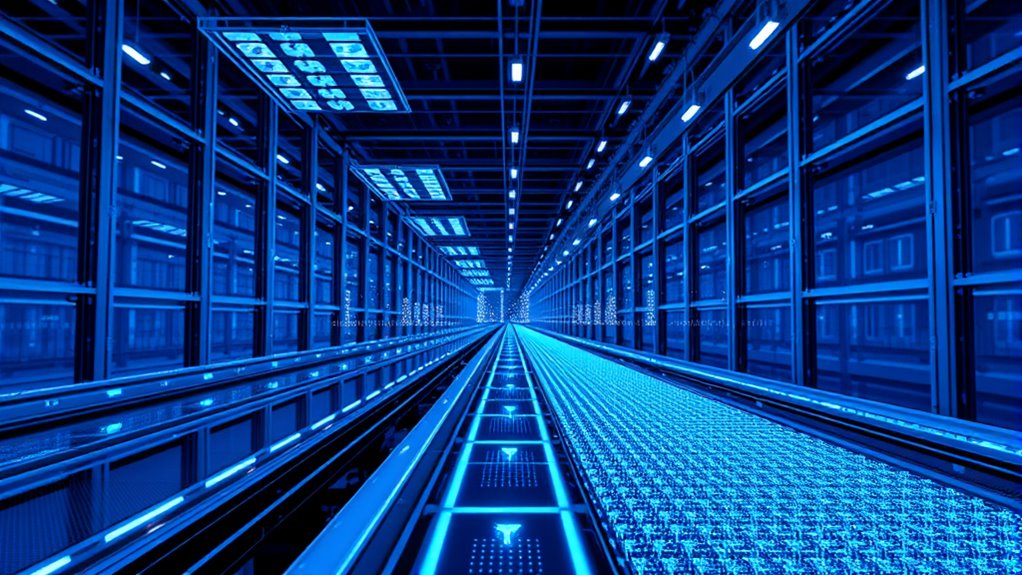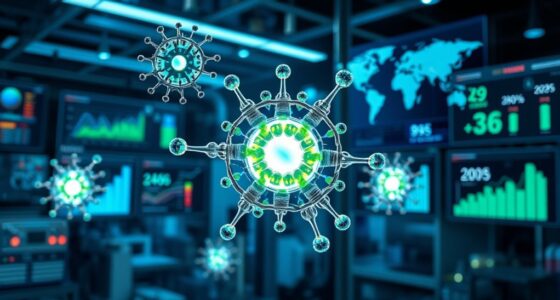Nanotechnology is transforming supply chains by enabling stronger, lighter materials that improve product durability and reduce transport costs. It helps you optimize inventory with smarter, longer-lasting items and accelerates innovation in packaging, safety, and tracking. These advancements support sustainability by using eco-friendly materials and reducing environmental impact. As a result, your supply chain becomes more resilient, efficient, and competitive. Continue exploring to uncover how these innovations can give you a strategic edge.
Key Takeaways
- Nanotechnology enables the creation of lightweight, durable materials that reduce transportation costs and environmental impact.
- It facilitates smarter inventory management through nanomaterial-enhanced sensors and tracking devices.
- Nanotech improves packaging safety and shelf life, expanding market reach and reducing waste.
- It promotes sustainable supply chains by developing biodegradable and recyclable materials.
- Nanotechnology drives innovation, offering competitive advantages through enhanced product quality and process efficiencies.

Nanotechnology is revolutionizing supply chains by enabling the development of stronger, lighter, and more efficient materials. This breakthrough allows you to improve product quality while reducing weight and material costs. With nanomaterials, you can enhance the durability of packaging, making shipments more resistant to damage and spoilage. This material enhancement leads to fewer returns and replacements, streamlining your logistics and lowering expenses. Additionally, lighter materials mean less fuel consumption during transportation, cutting costs and environmental impact. As a result, nanotechnology directly influences your supply chain’s efficiency and sustainability.
Nanotechnology enhances supply chains with stronger, lighter materials that improve durability, reduce costs, and promote sustainability.
One of the key benefits of nanotechnology is its role in inventory optimization. By creating advanced materials that last longer and perform better, you can reduce the need for frequent replacements and stockpile fewer spare parts. This means you can manage your inventory more precisely, avoiding overstocking and understocking issues. Nanomaterials enable the production of smarter, more durable goods that require less maintenance, which simplifies inventory planning. You’ll spend less time managing excess stock, freeing resources for other strategic initiatives. *furthermore*, improved material properties allow for the miniaturization of components, which can further decrease the size of inventory items and optimize storage space. Moreover, the growing influence of pop culture and entertainment industries like WWE Raw can impact consumer preferences, driving demand for innovative, high-quality products enhanced by nanotechnology.
Nanotechnology also accelerates innovation in supply chain processes. You can develop new, lightweight packaging solutions that extend shelf life and improve product safety, reducing waste and spoilage. These innovations mean you can ship products over longer distances without quality issues, expanding your market reach. Additionally, nanomaterials can be integrated into sensors and tracking devices, giving you real-time visibility over your inventory and shipments. This increased transparency helps you make faster, data-driven decisions, minimizing delays and disruptions.
*besides that*, nanotechnology supports sustainable supply chain practices. By creating eco-friendly materials that are biodegradable or recyclable, you reduce your environmental footprint. This aligns with growing consumer demand for responsible sourcing and can enhance your brand reputation. As regulations become stricter, nanomaterials can help you meet compliance standards more easily, avoiding costly penalties. Overall, nanotechnology empowers you to build more resilient, efficient, and sustainable supply chains by transforming materials and optimizing inventory management. You gain a competitive edge through innovation, cost savings, and improved service levels, all driven by the remarkable capabilities of nanomaterials.
Frequently Asked Questions
How Does Nanotechnology Impact Supply Chain Sustainability?
You see nanotechnology improves supply chain sustainability by reducing environmental impact through lighter, stronger materials and more efficient processes. However, you also face regulatory challenges, as strict rules may slow adoption or increase costs. By embracing nanotech, you can minimize waste and energy use, but it’s vital to stay compliant with evolving regulations to guarantee long-term sustainability and competitive advantage in your supply chain operations.
What Are the Cost Implications of Implementing Nanotech in Logistics?
You’ll find that implementing nanotech in logistics involves significant cost analysis, upfront investments, and ongoing expenses. While nanotechnology can reduce long-term operational costs through enhanced efficiency, initial investment challenges include high research, development, and equipment costs. You may face hurdles in justifying these expenses and balancing short-term costs with long-term benefits, but strategic planning can help you navigate these financial implications effectively.
Are There Safety Concerns With Nanomaterials in Supply Chains?
Yes, there are safety concerns with nanomaterials in supply chains. You need to take into account environmental risks, as nanomaterials might pose health hazards if released into the environment. Additionally, regulatory challenges can complicate their handling and transportation, requiring strict compliance measures. You must stay informed about evolving safety standards and ensure proper containment and disposal practices to protect workers and the environment from potential nanomaterial hazards.
How Does Nanotech Influence Supply Chain Transparency and Traceability?
Nanotech boosts supply chain transparency and traceability through nano-enhanced tracking and molecular authentication. You can use nano-enhanced sensors to monitor products in real-time, ensuring authenticity and detecting potential counterfeits. Molecular authentication verifies each item’s origin at a microscopic level, helping you prevent fraud and improve accountability. By integrating these nanotech solutions, you gain precise, reliable data, making your supply chain more transparent and easier to trace from origin to delivery.
What Industries Benefit Most From Nanotechnology Advancements in Supply Chains?
You’ll find that industries like healthcare and environmental monitoring benefit most from nanotechnology advancements in supply chains. Medical applications leverage nanoparticles for better drug delivery and diagnostics, improving patient outcomes. Environmental monitoring uses nanosensors for detecting pollutants and tracking climate changes more accurately. These innovations make supply chains more efficient and responsive, ensuring products and data reach their destinations faster, safer, and with greater precision, ultimately transforming how these industries operate and serve their customers.
Conclusion
As you embrace nanotechnology’s potential, you’re revealing a future where supply chains become a finely tuned symphony, each tiny innovation playing a vital part. This technology acts like a beacon, guiding you through complexities and uncertainties with the promise of efficiency and resilience. By harnessing these nanoscale marvels, you’re not just keeping pace—you’re shaping a smarter, stronger supply chain that can weather any storm. The future is now, and it’s shimmering with limitless possibilities.









